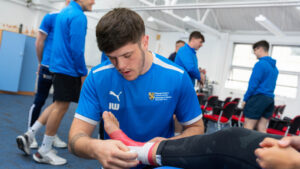Safeguarding Goalkeepers’ Hands: Why Finger and Wrist Support in Gloves Matters

Goalkeepers in football face unique challenges, and their hands are undeniably one of their most critical assets. Safeguarding these invaluable tools is of utmost importance, as they enable keepers to make crucial saves and keep the opposing team at bay. In this article, we explore the significance of finger and wrist support in goalkeeper gloves, highlighting the essential features that not only protect but also enhance a goalkeeper’s performance.
The Role of Finger Support
During a game, a goalkeeper’s fingers are highly exposed and vulnerable. Without adequate protection, they become susceptible to injuries such as sprains, dislocations, and fractures. Goalkeeper gloves equipped with finger support systems significantly reduce these risks. Typically, these gloves incorporate built-in finger spines or stays that run along the back of the fingers, providing stability and preventing overextension or unnatural bending. This support not only minimises the chances of finger injuries but also ensures optimal performance during critical moments.
Enhancing Wrist Stability
While finger support is crucial, the wrists are equally prone to injuries in the demanding environment of goalkeeping. The repetitive strain and impact experienced during dive catches, and punches can result in sprains, strains, or even more severe conditions like wrist instability. Recognising this, goalkeeper gloves incorporate features that promote wrist stability and protection. Adjustable straps or bands secure the wrist, offering enhanced support and reducing the risk of sudden movements that could lead to injury.
Impact Absorption and Padding
Goalkeeper gloves are meticulously engineered to provide effective impact absorption and padding. The palm area, in particular, is equipped with cushioning materials, such as latex foam, which minimise the impact when catching or punching the ball. This padding acts as a shock absorber, reducing the strain on the hands and decreasing the likelihood of bruising or more severe injuries.
Grip and Control
A goalkeeper’s ability to prevent goals heavily relies on their grip and control. Premium goalkeeper gloves employ advanced grip technologies, such as sticky latex palm surfaces or specialised patterns, to enhance ball control and handling. These features enable goalkeepers to maintain a firm grip on the ball, even in challenging weather conditions or when the ball is wet. As a result, the risk of fumbles or accidental slips that could lead to conceding a goal is significantly minimised.
Customisation and Fit
Each goalkeeper has unique hands, necessitating gloves that offer a snug and comfortable fit. Proper fit ensures maximum dexterity while minimising the chances of injury. Many goalkeeper glove brands offer a range of sizes and customisation options, allowing goalkeepers to find the perfect fit for their hands. The ability to personalise gloves with various wrist closure systems, finger protection configurations, and palm types further contributes to optimising both safety and performance.
Final words
Goalie gloves play a vital role in protecting goalkeepers’ hands and wrists while enhancing their overall performance on the field. Finger and wrist support systems, along with impact absorption, padding, grip, and customised fit, collectively reduce the risk of injuries and empower goalkeepers to excel in their roles. By acknowledging the significance of high-quality goalkeeper gloves, players can prioritise hand safety, ensuring they are always prepared to make those crucial game-changing saves.





